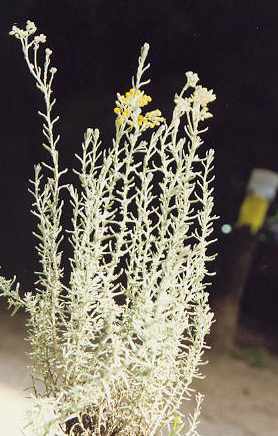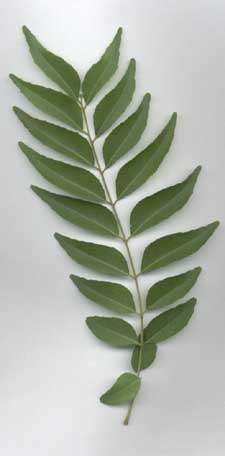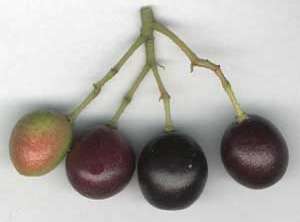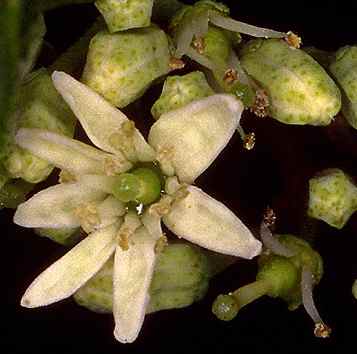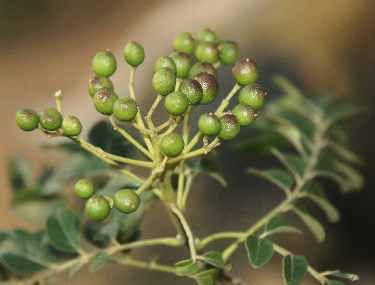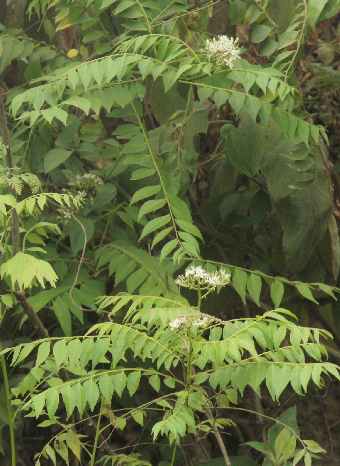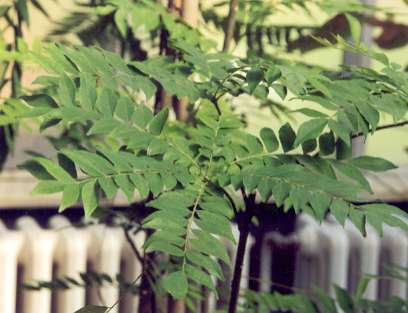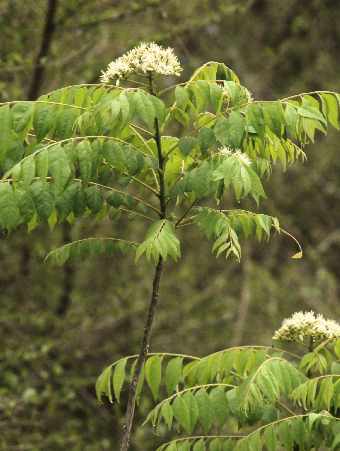
|
|
Flowering wild curry tree
|
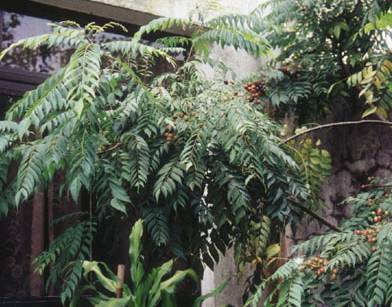
|
|
Curry tree with fruits
© Liz Thomas
|
Curry leaves are extensively used in Southern India and Sri
Lanka (and are absolutely necessary for the authentic flavour), but are also of
some importance in Northern India. Together with South Indian immigrants,
curry leaves reached Malaysia, South Africa and Réunion island.
Outside the Indian sphere of influence, they are rarely found.

|
|
Curry tree with fruits
© Liz Thomas
|
Curry powder is a British invention to imitate the flavour of Indian
cooking with minimal effort. Some curry powders, or so the books tell, indeed
contain curry leaves, but probably only for historic or linguistic reasons,
since dried curry leaves lose their fragrance within days. A typical curry
powder should derive its taste mainly from toasted cumin, toasted coriander,
black pepper, chiles
and toasted fenugreek. Other typical Indian spices
often contained in curry powders are dried ginger,
ajwain and celery
(as a substitute for Indian radhuni), furthermore salt, flour
from lightly toasted lentils and aromatic Moghul spices in variable amounts
(cinnamon, cloves,
green cardamom,
Indian bay-leaves). The yellow colour stems from
turmeric.
I think it’s pretty unreasonable to put spices with absolutely no tradition
in India into a spice blend that claims to have an Indian flavour
,
but nevertheless galangale,
caraway, allspice,
and zedoary are occasionally listed as ingredients
in curry powders. Remember that since curry powder is not a
traditional recipe, there is little consensus about what should go into it,
and anyone is free to sell his own creation.
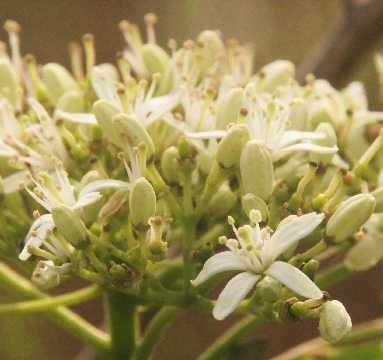
|
|
Curry tree flower
|
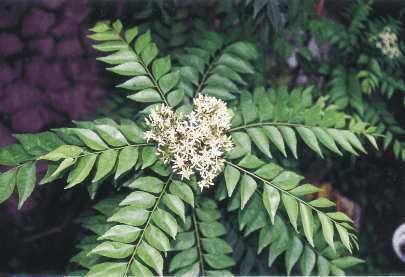
|
|
Curry tree in full flower
© Liz Thomas
|
Observant readers will notice that the recipe for curry powder outlined in the
previous paragraph appears like a compromise of the Northern Indian garam masala and the Southern Indian sambar
podi (see cumin and coriander, respectively). Anyway,
you cannot represent the large spectrum of Indian cooking styles in one
single spice mixture; Indians prepare their mixtures separately for each dish
and usually do not store them, thus guaranteeing the unique flavour of each
recipe. Curry powder, therefore, belongs more to British or international
cuisine than to India; anyone trying to cook authentic Indian recipes should
stick to traditional Indian spice mixtures or, even better, single spices.
Western-style curry powder has been introduced to some Far Eastern countries in the past,
and today plays but a minor rôle as a flavouring in China, Indonesia
and, above all, Vietnam.

|
|
Curry tree in full flower
© Liz Thomas
|
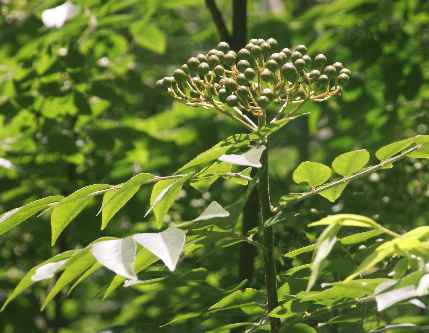
|
|
Unripe curry fruits
|
While there is no curry powder in India, Sri Lanka has a common spice mix somewhat similarto the Western product, though i
lacks turmeric and is therefore of brown colour. The blend is referred to as curry powder
in Sri Lankan English,
as tunapaha kudu [තුනපහ කුඩු] in Sinhala and as
karittul [கறித்தூள்]
or masala tul [மசால தூள்]) in Tamil language.
A version with maximum degree of toasting is known as
baedapu tunapaha kudu [බැදපු තුනපහ කුඩු]
or varutta karittul [வறுத்த கறித்தூள்] roasted curry powder
and contains
also some toasted rice grains as an additional source of roast flavour.
In any case, Sri Lankan curry powder consists of various spices like cumin, coriander, fennel, cinnamon,
cloves, black pepper and chiles
which have been toasted prior to grinding; these powders do contain turmeric, but not enough to reach the same bright yellow colour
as a typical Western curry powder. Also, the toasted legume component is absent from Sri Lankan curry powder.
This blend has been introduced to the Caribbean where it is known as Colombo powder or Poudre de Colombo.
All these powders may contain small amounts of curry leaves (less likely in the Caribbean), but the taste will be dominated by the other spices.
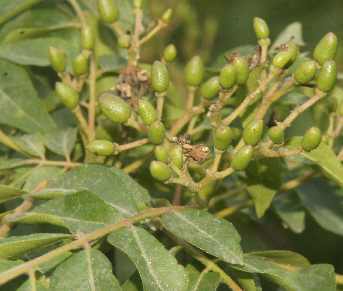
| |
Fruit-bearing Curry Tree (growing wild in Nepal)
|
|
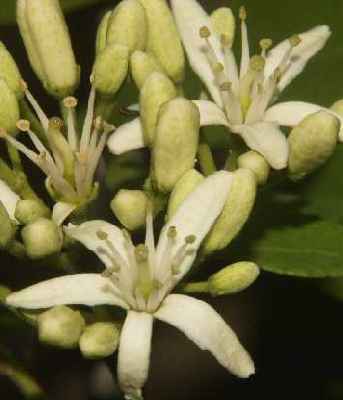
| |
Curry tree flowers
|
|

|
|
Unripe curry fruits
|
In Indian cuisines, curry leaves are used fresh. They develop their flavour best after a short heating; thus, they
are often fried in butter or oil as a part of the spice mix that marks the beginning of a preparation and gives a unique flavour to the food
(baghar, see onion); in South India, they are often employed in
tarka-like preparation that flavour foods after cooking and just before serving (see ajwain).
Since South Indian cuisine is dominantly vegetarian, curry leaves seldom appear in non-vegetarian
food; the main applications are thin lentil or vegetable curries
(sambaar [சாம்பார்]),
the typically South Indian dry curries, which consist just of vegetable pieces sautéed with spices,
and also in some rice dishes like bisi bele (see coconut).
In the North, they are mostly found in the stuffings for the crispy
samosa [समोसा].
Because of their soft texture, they are never removed before serving,
but can be eaten without any hazard.

|
|
Curry tree flowers
|
Although curry leaves really must be fresh, they can be dried in a hot pan or deep-fried in fat immediately before usage; then, they will not
only retain their fragrance and dark green colour, but also acquire a very pleasant, crispy texture. I’ll never forget a South Indian
beef fry which was prepared by Muslim cooks in Karnataka: Lean beef cubes were marinated with joghurt and a spice mix quite similar to
the blends used for North Indian tandoori foods; then, they were deep-fried and mixed with crispy curry leaves. This type
of usage is, however, mostly found in Sri Lanka, for example in the national rice dish
buriyani [බුරියානි],
a mild rice flavoured with turmeric and other spices and usually served with chicken pieces. Hot-dried
or deep-fried curry leavs can also be ground to a fragrant powder and may appear in spice blends, but their fragrance will not last
very long.
In Sri Lanka, the delicious chicken and beef curries are flavoured with curry
leaves; the leaves are furthermore used for kottu roti [කොත්තු රොටී],
vegetables and sliced bread which are quickly fried together. Sri Lankan
cooking is very hot and pungent due to almost excessive use of
chiles, but also very aromatic. Compared to
Indians, Sri Lankans eat more meats and less dairy products;
meats and vegetables are often cooked in gravies based on water or
thin coconut milk instead of yoghurt.

|
|
Curry tree sapling
|

|
|
Flowering curry tree
|
The typical Sri Lankan flavour is due to heavy toasting some spices
(cumin, coriander, black mustard, fenugreek)
until they reach a rather dark colour; it is often said that Sri Lankan
curries have a darker
or browner
flavour than Indian curries. Sri
Lankan cooks often
use aromatic spices native to the island (cinnamon,
cardamom) and fresh leaves (curry leaves,
Pandanus leaves and lemon
grass; the latter two are not in common use in India).
Curry leaves may be kept in the refrigerator for some time, but are better kept
frozen; do not tear them from their stems before usage!
The term curry is applied inflationarily to many dishes of Far Eastern
origin. As shown above, in its true home South India it means a thin, spicy
vegetable stew. In Thailand, though, any food cooked in coconut milk is called a curry
(gaeng [แกง]); the term is similarly
used in Vietnam, where curries (ca ri [ca ri], see rice paddy herb)
are indeed often flavoured with Anglo–Indian curry powder.
Laksa, a soupy noodle dish from Malaysia and Singapore,
is often referred to as curried noodles
or the like, probably, because
it contains coconut and derives the familiar
yellow colour from turmeric (see
Vietnamese coriander for details about
laksa).

|
|
Flowering curry tree
|
In Burma, however, a completely different definition of curry
is in use:
Burmese curries
owe their flavour to a fried paste of ground
onions and other spices (see
onion for details). Lastly, in Indonesia,
any spicy food may be termed a curry (kari
in Indonesian). Sometimes, one even hears about Ethiopian
(see long pepper) or Caribbean curries
,
whatever this may mean (except, perhaps, the least common denominator of all
those: Spiciness).







